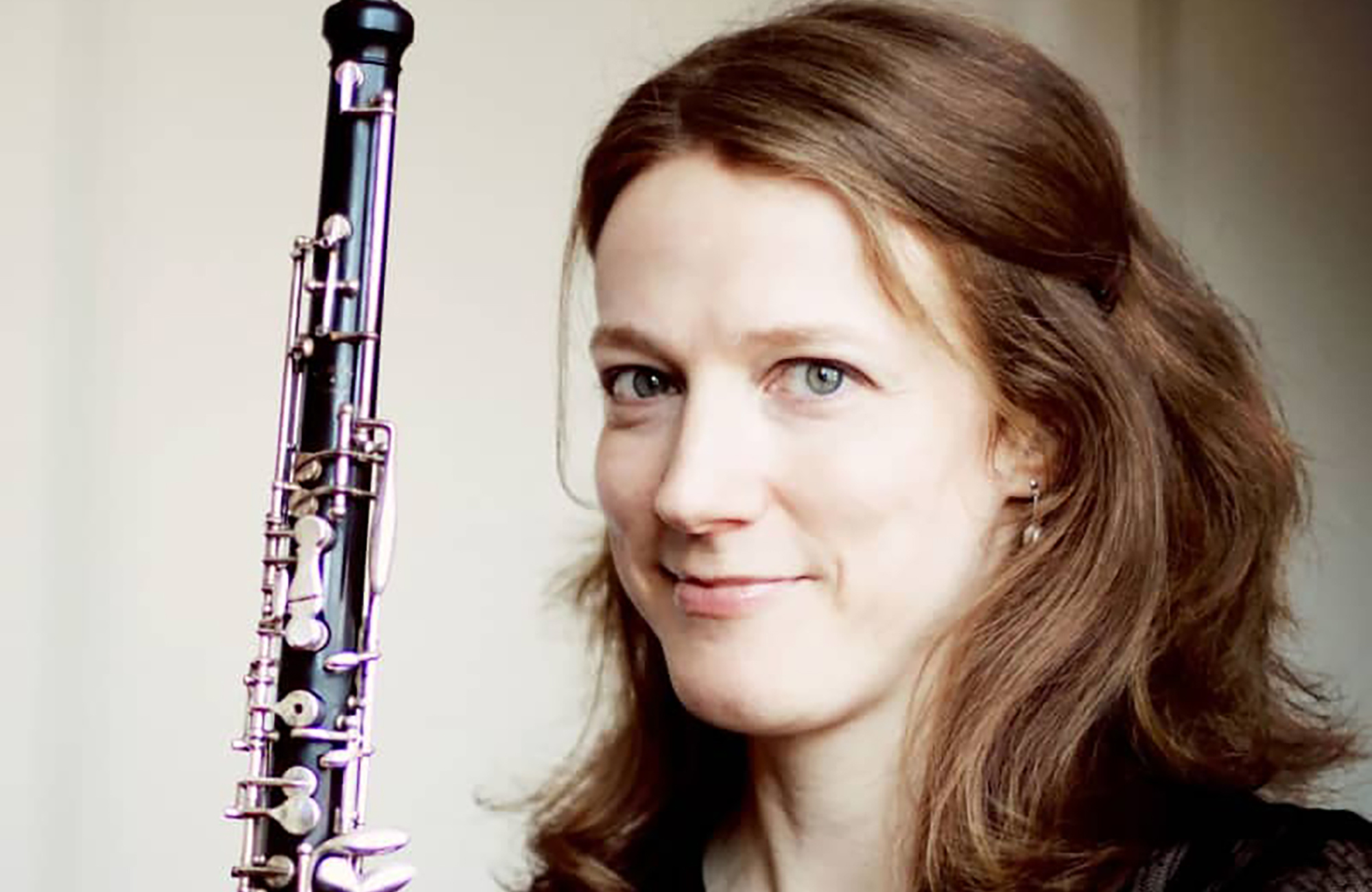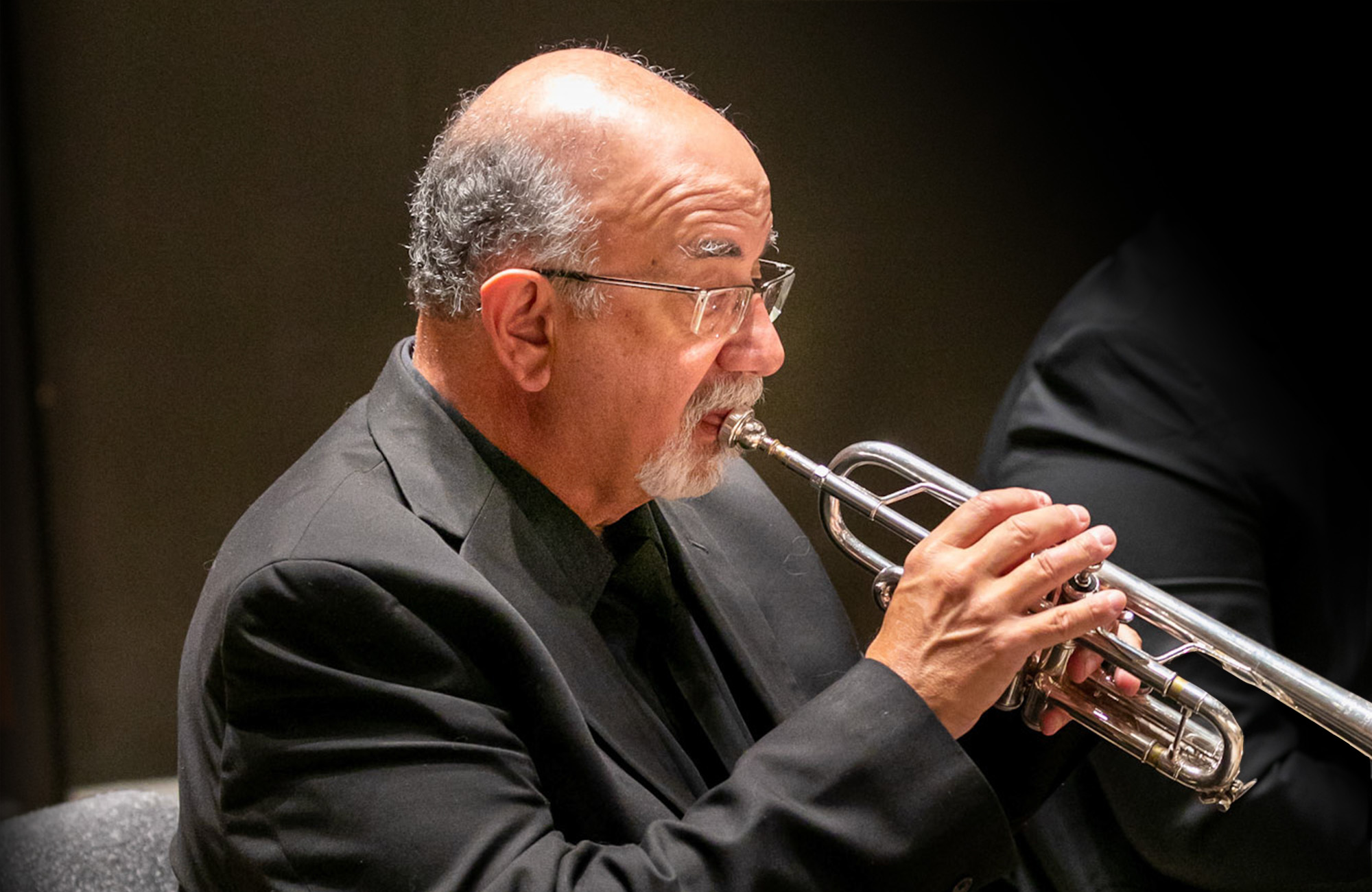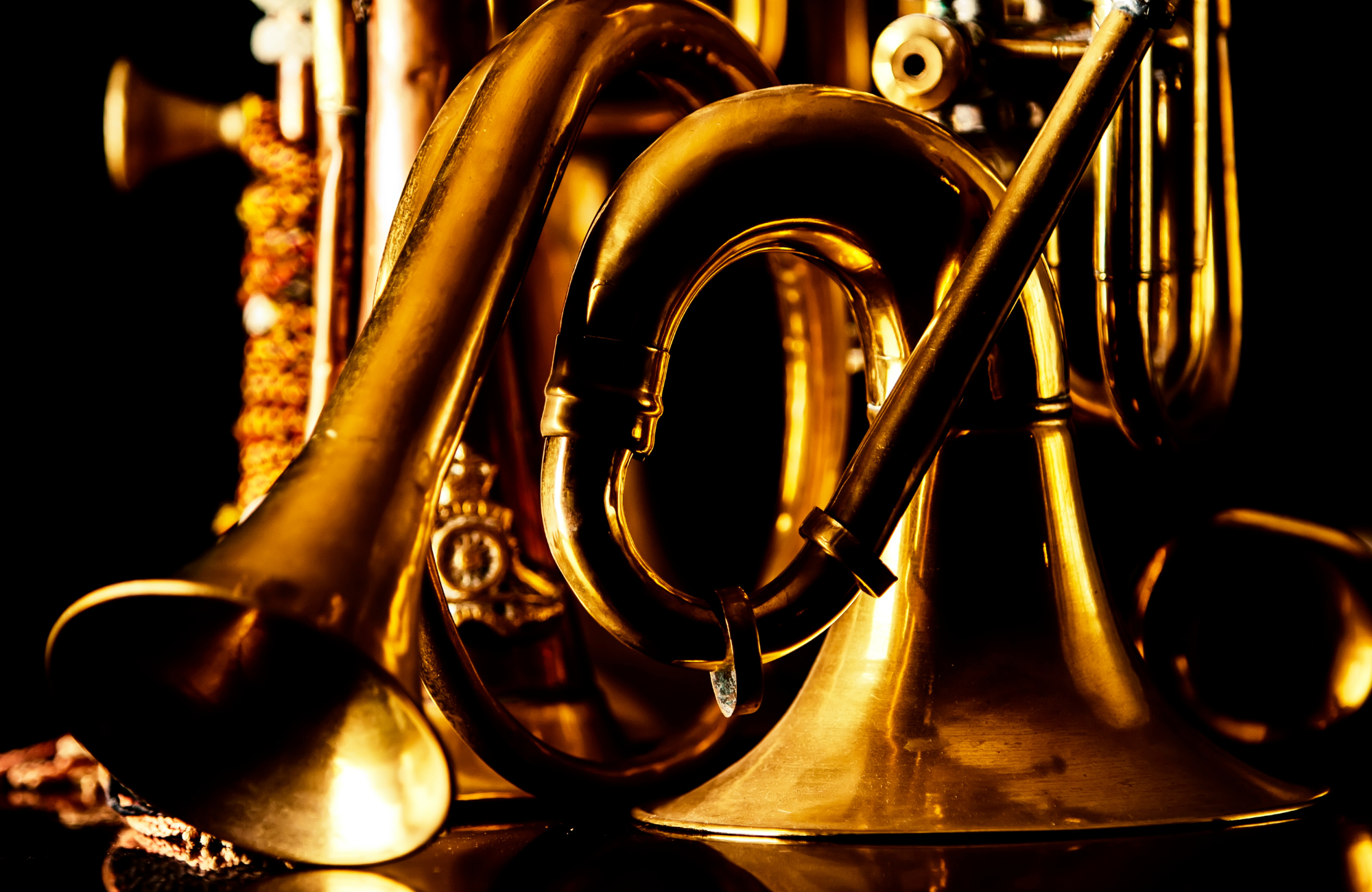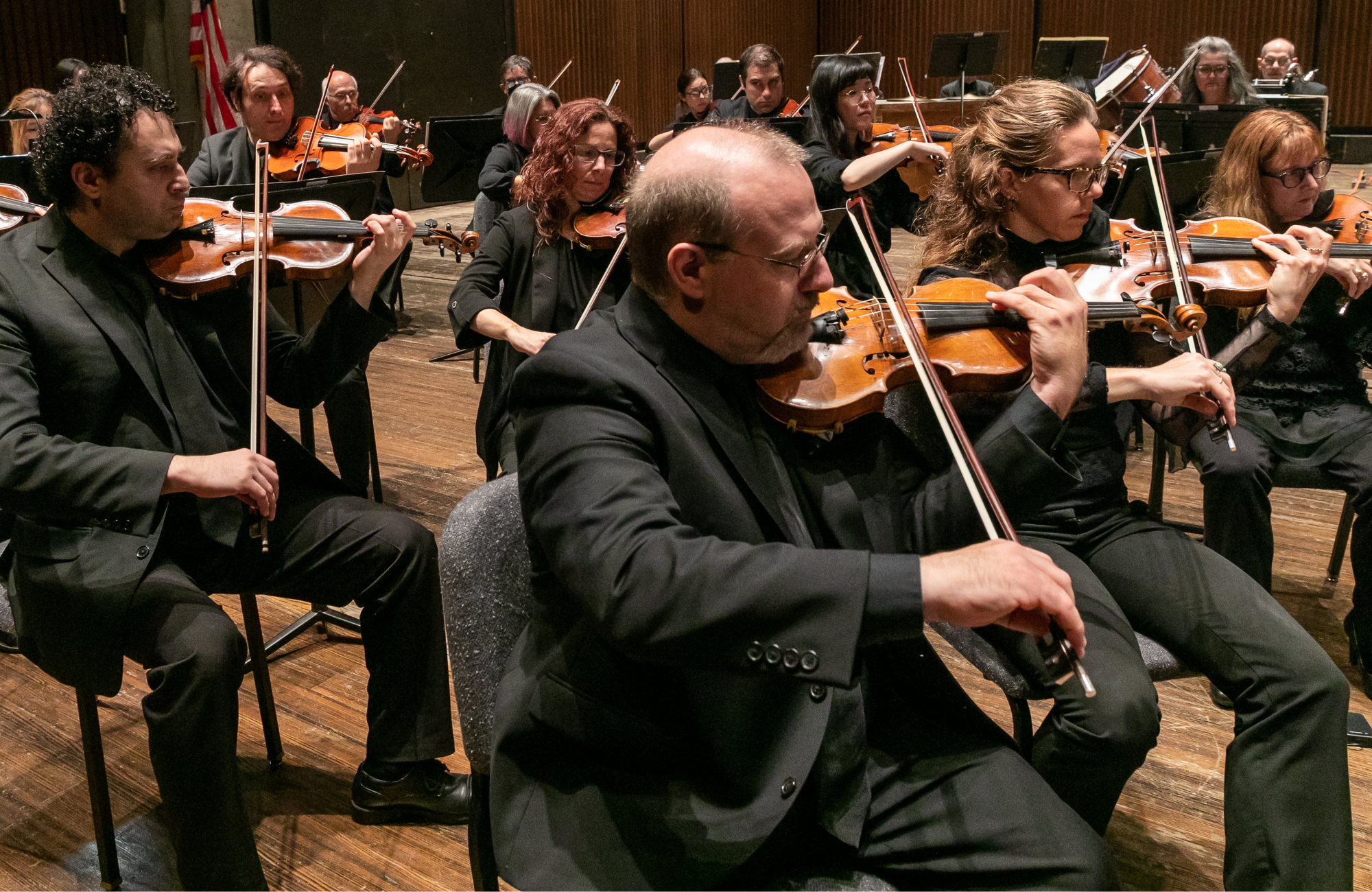The Syracuse Orchestra welcomes back Monica Fosnaugh, English horn player from the Detroit Symphony Orchestra, to join principal trumpet John Raschella in a performance of Copland’s Quiet City. The work is bookended by Shostakovich’s Chamber Symphony at the start and Bach’s Orchestral Suite No. 4 in D Major to complete the afternoon.
PROGRAM
SHOSTAKOVICH: Chamber Symphony, Op. 110a ![]()
COPLAND: Quiet City ![]()
J.S. BACH: Orchestral Suite No.4 in D major, BWV 1069 ![]()
*NO INTERMISSION
Thanks to our sponsors for this performance!
PROGRAM NOTES
The Chamber Symphony, op. 110a is an adaptation for full string orchestra, by Rudolf Barshai, of the String Quartet No. 8 by Dmitri Shostakovich (1906–1975). The official story behind the original work is straightforward. In 1960, Shostakovich was in Dresden, working on the score for Five Nights and Five Days, a film celebrating the Soviet rescue of art works buried in the rubble after the Allied bombing in 1945. Devastated by the massive destruction of the city, he was inspired to interrupt his primary task in order to write ...
The Chamber Symphony, op. 110a is an adaptation for full string orchestra, by Rudolf Barshai, of the String Quartet No. 8 by Dmitri Shostakovich (1906–1975). The official story behind the original work is straightforward. In 1960, Shostakovich was in Dresden, working on the score for Five Nights and Five Days, a film celebrating the Soviet rescue of art works buried in the rubble after the Allied bombing in 1945. Devastated by the massive destruction of the city, he was inspired to interrupt his primary task in order to write a five-movement quartet (played without pause) dedicated it to “the victims of fascism and the war.” He wrote it quickly but with unusual intensity; it has since become one of his most frequently performed compositions—probably the most recorded post-War piece of chamber music.
But like everything having to do with Shostakovich, it’s more complicated than the official story suggests—and it gets more complicated the more we learn about his experiences. Yes, the Eighth Quartet is clearly a response to the destruction of Dresden—but it’s also an autobiographical outcry. It’s not only that it makes significant use of the musical motif DSCH (D-E flat-C-B, using traditional German nomenclature) which Shostakovich used frequently to refer to himself (using the German spelling of his name, D. Schostakowitsch). More striking, it quotes extensively from a large number of his earlier works. But what’s the slant of that autobiography? It’s not easy to be sure, since the Quartet is a multi-layered work laced with ironies and contradictions.
First, it bears witness to Shostakovich’s own suffering in the Soviet Union. Among the quotations, we find a well-known Russian prison song (“Tortured by grievous bondage”) as well as music from Lady Macbeth of Mtsensk—the opera that so enraged Stalin that Shostakovich, formerly a Soviet Hero, found himself fearing arrest. Indeed, the composer described “this ideologically flawed quartet,” in a letter to his friend Isaak Glikman, in somewhat self-pitying tones: “I started thinking that if some day I die, nobody is likely to write a work in memory of me, so I had better write one myself. The title page should carry the dedication: ‘To the memory of the composer of this quartet.’” But in typical Shostakovich fashion, he mocks that self-pity in the very same letter, calling the Quartet a pseudo-tragedy and disparaging his own tears (“I shed the same amount of tears as I would have to pee after half-a-dozen beers”). To further complicate matters, he suggests wryly that what he really admires about the work is not its programmatic content but its “superlative unity of form.”
Second, at the same time—and there is no irony here—it’s a declaration of his opposition to Soviet anti-Semitism. Shostakovich strongly identified with Jews, an identification announced in a great deal of his music (most strongly in his Thirteenth Symphony, written two years later, which sets Yevtushenko’s poem Babi Yar, a poem about the Nazi massacres near Kyiv). In the Eighth Quartet, we can hear it in his quotation of music from his Second Piano Trio, music with a strong Jewish flavor.
Need another strand of meaning? The work may also be an expression of Shostakovich’s own sense of guilt, for it’s haunted by recollections of Richard Strauss’s Metamorphosen for strings—also written in the response to the destruction of the war—in a way that ties the two composers together. And once you notice that connection, it’s hard not to hold Shostakovich’s compromises with Stalinism up against Strauss’s concessions to the Nazi regime. That comparison is all the more painful since while Strauss resisted joining the Nazi Party, Shostakovich did surprisingly join the Communist Party—under pressure—just around the time he wrote this Quartet.
In sum, it’s a dizzying work that resists easy interpretation—especially as we discover more about the composer. Yet, paradoxically, the immediacy of its impact has been consistent. Audiences never fail to be shaken by the experience of hearing it.
As I’ve suggested, over the years, the historical and personal context of its composition has become ever more central to discussions of the Shostakovich Eighth Quartet. At the same time, the opposite has been happening to Quiet City (1939) by Aaron Copland (1900 –1990): it has become increasing detached from its original context. It started out as part of the incidental music that Copland wrote for Irwin Shaw’s play of the same name. But once the composer recast it as an independent piece for strings, solo trumpet, and solo English horn, “it kind of abandoned its original meaning,” as tonight’s soloist Monica Fosnaugh puts it, and took on a life of its own—especially after the play (which had a total of two performances) disappeared from our collective memory.
Quiet City is a gentle work, often compared to Charles Ives’s The Unanswered Question. The title seems, at first, to be a contradiction, since cities (especially New York, where the play is set) are generally noisy. “So he’s talking about a very specific moment in time when the city is actually quiet,” says Monica, “when the quietness outside in the city is the quietness inside, the loneliness of being a single individual amongst a crowd.” The music also exhibits a slight sense of unease (perhaps a reflection of the shadow of war haunting Europe).
In a way, then, it’s a descriptive work. But it’s descriptive in its own way. Once again, Strauss is useful as a point of comparison—although with respect to Copland, it’s his differences that matter, not (as was the case with Shostakovich) his similarities. As Monica points out, many of Strauss’s works are “written so specifically about a certain thing; they tell a story, and it’s hard to imagine anything else happening.” Quiet City, in contrast, is more “open ended”—and, she says, like much of Copland’s music, with “its use of open intervals and the expansive quality of his writing, it allows the listener and the performer to bring their own experiences to the piece.” It’s a short work, with a slightly ambiguous ending; but in its ten minutes, it draws you in completely.
Quiet City depends heavily on the subtle interactions between the English horn and the solo trumpet (played today by principal trumpet John Raschella), who often exchange material, but who, says Monica, “can’t quite meet, like two ships in the night.” Monica, who played briefly here as a member of the orchestra, is especially “excited to get to come back to Syracuse and perform the piece with John. It’s going to be an incredible experience.” John is similarly enthusiastic about the prospect: “Quiet City has always been one of my favorite pieces. I haven’t performed it in at least 30 years but I have a favorite memory of doing it numerous times with a chamber group including Dan Carno, our English horn player, along with the late, great Calvin Custer playing the string parts on the synthesizer. It’ll be amazing to perform it with the full string section and our wonderful guest soloist Monica Fosnaugh!”
In their different ways, both the Shostakovich and the Copland are dark pieces. For our final selection, we move from into the light with the Suite No. 4 in D for Orchestra by Johann Sebastian Bach (1685–1750). No one knows how many orchestral suites Bach wrote, or what their exact chronology was. Four of them survive, each with a different instrumentation. The Fourth—with three oboes, bassoon, three trumpets, and timpani joining the strings—is the most spectacular, with an especially rich treatment of the winds, which get plentiful opportunities to shine. Like the other Suites, this one consists of an overture and a set of dances—in this case, filled with especially high spirits and rhythmic ingenuity. Check out, for instance, the syncopations that enliven the Minuet (a dance that can easily turn turgid). But it’s the closing “Rejouissance” (“Rejoicing”)—with its refusal of metrical regularity, reflected in the way its confrontation between triple and quadruple meter obscures the barlines—that would be most likely to trip up anyone trying to dance to it. For listeners sitting in the audience, though, it’s unalloyed joy.
Peter J. Rabinowitz
Have any comments or questions? Please write to me at prabinowitz@SyracuseOrchestra.org
FEATURED ARTISTS

Described as bringing an “artisan storyteller’s sensitivity… shaping passages with clarity and power via beautifully sculpted dynamics… revealing orchestral character not seen or heard before” (Arts Knoxville) Lawrence Loh enjoys a dynamic career as a conductor of orchestras all over the world.
After an extensive two ...
Described as bringing an “artisan storyteller’s sensitivity… shaping passages with clarity and power via beautifully sculpted dynamics… revealing orchestral character not seen or heard before” (Arts Knoxville) Lawrence Loh enjoys a dynamic career as a conductor of orchestras all over the world.
After an extensive two year search, Lawrence Loh was recently named Music Director of the Waco Symphony Orchestra beginning in the Spring of 2024. Since 2015, he has served as Music Director of The Syracuse Orchestra (formerly called Symphoria), the successor to the Syracuse Symphony Orchestra. “The connection between the organization and its audience is one of the qualities that’s come to define Syracuse’s symphony as it wraps up its 10th season, a milestone that might have seemed impossible at the beginning,” (Syracuse.com) The Syracuse Orchestra and Lawrence Loh show that it is possible to create a “new, more sustainable artistic institution from the ground up.”
Appointed Assistant Conductor of the Pittsburgh Symphony in 2005, Mr Loh was quickly promoted to Associate and Resident Conductor within the first three years of working with the PSO. Always a favorite among Pittsburgh audiences, Loh returns frequently to his adopted city to conduct the PSO in a variety of concerts. Mr. Loh previously served as Music Director of the West Virginia Symphony Orchestra, Music Director of the Northeastern Pennsylvania Philharmonic, Artistic Director and Principal Conductor of the Syracuse Opera, Music Director of the Pittsburgh Youth Symphony Orchestra, Associate Conductor of the Dallas Symphony Orchestra, Associate Conductor of the Colorado Symphony Orchestra and Music Director of the Denver Young Artists Orchestra.
Mr. Loh’s recent guest conducting engagements include the San Francisco Symphony, Dallas Symphony, North Carolina Symphony, Baltimore Symphony, Sarasota Orchestra, Florida Orchestra, Pensacola Symphony, Atlanta Symphony, National Symphony, Detroit Symphony, San Diego Symphony, Seattle Symphony, National Symphony (D.C.), Utah Symphony, Rochester Philharmonic, Indianapolis Symphony, Calgary Philharmonic, Buffalo Philharmonic, Albany Symphony and the Cathedral Choral Society at the Washington National Cathedral. His summer appearances include the festivals of Grant Park, Boston University Tanglewood Institute, Tanglewood with the Boston Pops, Chautauqua, Sun Valley, Shippensburg, Bravo Vail Valley, the Kinhaven Music School and the Performing Arts Institute (PA).
As a self-described “Star Wars geek” and film music enthusiast, Loh has conducted numerous sold-out John Williams and film music tribute concerts. Part of his appeal is his ability to serve as both host and conductor. “It is his enthusiasm for Williams’ music and the films for which it was written that is Loh’s great strength in this program. A fan’s enthusiasm drives his performances in broad strokes and details and fills his speaking to the audience with irresistible appeal. He used no cue cards. One felt he could speak at filibuster length on Williams’ music.” (Pittsburgh Tribune)
Mr Loh has assisted John Williams on multiple occasions and has worked with a wide range of pops artists from Chris Botti and Ann Hampton Callaway to Jason Alexander and Idina Menzel. As one of the most requested conductors for conducting Films in Concert, Loh has led Black Panther, Star Wars (Episodes 4-6), Jaws, Nightmare Before Christmas, Jurassic Park, Casablanca, The Wizard of Oz and Singin’ in the Rain, among other film productions.
Lawrence Loh received his Artist Diploma in Orchestral Conducting from Yale, his Masters in Choral Conducting from Indiana University and his Bachelor of Arts from the University of Rochester. Lawrence Loh was born in southern California of Korean parentage and raised in Carlisle, Pennsylvania. He and his wife Jennifer have a son, Charlie, and a daughter, Hilary. Follow him on instagram @conductorlarryloh or Facebook at @lawrencelohconductor or visit his website, www.lawrenceloh.com

Monica Fosnaugh joined the Detroit Symphony Orchestra in 2012, appointed as the orchestra’s English Horn by Music Director Laureate Leonard Slatkin. Prior to joining the DSO, Fosnaugh held positions with the New Haven Symphony, the Syracuse Symphony, the Rochester Philharmonic, and the Kalamazoo ...
Monica Fosnaugh joined the Detroit Symphony Orchestra in 2012, appointed as the orchestra’s English Horn by Music Director Laureate Leonard Slatkin. Prior to joining the DSO, Fosnaugh held positions with the New Haven Symphony, the Syracuse Symphony, the Rochester Philharmonic, and the Kalamazoo Symphony Orchestra, as well as the Colorado Music Festival in Boulder. She was also an oboe fellow at the New World Symphony in Miami Beach where she played under the baton of Michael Tilson Thomas. Fosnaugh has been featured as a soloist with the DSO performing works by Aaron Copland and Leonard Slatkin.
A native of Lima, Ohio, Fosnaugh began playing the oboe at age 10 and spent eight years studying with Patricia Nott. She attended the Cleveland Institute of Music where she studied with John Mack, the former Principal Oboe of The Cleveland Orchestra. Fosnaugh continued her studies with Robert Atherholt at Rice University in Houston, Texas. While in school, she spent summers at the Chautauqua Institute, the Kent/Blossom Music Festival, and the National Repertory Orchestra.
In addition to her work with the DSO, Fosnaugh regularly performs in solo and chamber recitals on both oboe and english horn. She also provides instruction through private coaching and giving masterclasses around the metro Detroit-area and throughout the US.

John Raschella is currently Principal Trumpet with Symphoria. Prior to that for 30 years he was Principal Trumpet and Associate Principal trumpet of the Syracuse Symphony Orchestra. He has performed as Co Principal trumpet with the Pittsburgh Symphony and has performed with the Philadelphia Orchestra along with the symphony orchestras ...
John Raschella is currently Principal Trumpet with Symphoria. Prior to that for 30 years he was Principal Trumpet and Associate Principal trumpet of the Syracuse Symphony Orchestra. He has performed as Co Principal trumpet with the Pittsburgh Symphony and has performed with the Philadelphia Orchestra along with the symphony orchestras of Houston, Minnesota, Buffalo, Rochester and Jacksonville. He has also been a featured performer at the International Trumpet Guild Conference and has recorded with the Pittsburgh and Syracuse Symphony Orchestras. In the summers he has performed as principal trumpet of the Eastern Music Festival in N Carolina and the Spoleto festival in Italy as well as a frequent performer at the Skaneateles festival.
Mr. Raschella attended the Manhattan School of Music and the Curtis Institute of Music where he received an artist diploma. Mr. Raschella has taught at Ithaca College and is on the faculties of Hamilton College and Syracuse University. He has given master classes at The Curtis Institute, Ithaca College and Nazareth College.
Mr. Raschella is a native of Syracuse having grown up in Dewitt and remembers his first musical experience as going to a young persons concert at the war memorial and hearing the Syracuse Symphony at the age of 9. It changed his life and turned him on to classical music! His children are also musicians with daughter Mary (violin) a string teacher in the Williamsville school district and son David (french horn) who is attending the Juilliard school.
When not playing the trumpet you will find he and his wife Bonnie aboard their boat “BonGiovanni” where they love to cruise the Erie Canal and the great lakes!



